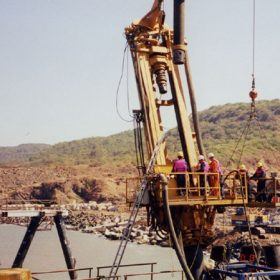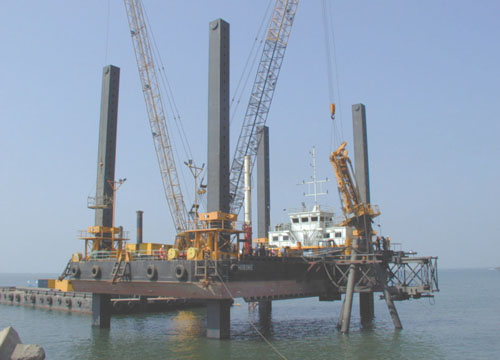
| Application | Pier Pile Drilling |
|---|---|
| Location | Maharastra, Southwest India |
| Hammer | Champion RC210 |
| Bit | Reverse Circulation |
| Hole Size | 24 inch (610 mm) |
| Depth or Length | 10 - 33 feet (3 - 10 m) |
| Formation | Basalt |
| Rig Type | 2 - NC Brunello RCD Rig on a self-elevating platform |
Description
 In southwestern India on the coast of the Indian Ocean, Numa’s Champion RC210 reverse circulation hammers and bits have been hard at work on a pier pile installation project that is part of the construction of the Dabhol Power Plant.
In southwestern India on the coast of the Indian Ocean, Numa’s Champion RC210 reverse circulation hammers and bits have been hard at work on a pier pile installation project that is part of the construction of the Dabhol Power Plant.
The project called for the installation of over one mile (1.7 km) jetty including a jetty head and dolphins in order to off-load LNG for the newly constructed power plant. The contract for construction of the jetty and the jetty head was awarded to the joint venture Besix (Belgium) Kier (UK).
To support the extremely long jetty, 500 piles were required with a rake of 1:3 (18 degrees). Drill plans originally called for the piles to be installed using a roller bit drilling method but this proved to be too slow. The contractors decided to use DTH RC drilling in order to speed up the completion of the holes. A Numa distributor, Geotec of Belgium supplied two (2) Numa RC210 hammers and several 24″ (610 mm) bits.
 The reverse circulation drilling method provides an environmentally sensitive alternative that can eliminate traditional hole cleaning problems typically found with conventional hammers. The Champion RC210 utilizes dual wall drill pipe and high-pressure air to efficiently clean the hole. The principles of RC drilling and dual wall pipe are fairly simple. Air is forced down the annular space between the outer and inner pipe and is exhausted out the outer edge of the RC bit. All cuttings and down hole samples are then forced (vacuumed) back up through the center of the bit and inner pipe (collection tube) to be safely collected and discarded at the surface. With this method, no foam is required to clean the hole and lubricants are not free to contaminate the formation.
The reverse circulation drilling method provides an environmentally sensitive alternative that can eliminate traditional hole cleaning problems typically found with conventional hammers. The Champion RC210 utilizes dual wall drill pipe and high-pressure air to efficiently clean the hole. The principles of RC drilling and dual wall pipe are fairly simple. Air is forced down the annular space between the outer and inner pipe and is exhausted out the outer edge of the RC bit. All cuttings and down hole samples are then forced (vacuumed) back up through the center of the bit and inner pipe (collection tube) to be safely collected and discarded at the surface. With this method, no foam is required to clean the hole and lubricants are not free to contaminate the formation.
 This project was extremely demanding due to its remote location and the rapidly approaching monsoon season. With no existing infrastructure, the contractors assembled or built everything they needed in order to complete the project. A NC Brunello RCD rig was built on a self-elevating platform which allowed for critical adjustments according to conditions at each hole. The contractor also installed four (4) Atlas Copco SR870 850/250 compressors to supply the RC210 with 175 psi (12 bar) while drilling. Their innovation and hard work paid off as they were able to complete a year’s worth of work into an eight month period. This was critical as they were able to complete their assignments prior to the monsoon season which yielded 4 – 6 inches (102 – 152 mm) of rain a day and 25 foot (7.6 m) high waves that could have severely damaged the drilling rig and platform.
This project was extremely demanding due to its remote location and the rapidly approaching monsoon season. With no existing infrastructure, the contractors assembled or built everything they needed in order to complete the project. A NC Brunello RCD rig was built on a self-elevating platform which allowed for critical adjustments according to conditions at each hole. The contractor also installed four (4) Atlas Copco SR870 850/250 compressors to supply the RC210 with 175 psi (12 bar) while drilling. Their innovation and hard work paid off as they were able to complete a year’s worth of work into an eight month period. This was critical as they were able to complete their assignments prior to the monsoon season which yielded 4 – 6 inches (102 – 152 mm) of rain a day and 25 foot (7.6 m) high waves that could have severely damaged the drilling rig and platform.
 Each hole was completed in a two (2) step process using a casing hammer and DTH reverse circulation hammer and bit. The casing hammer was used with nitrogen charges to drive the piles until refusal. At this point, the RC210 was lowered inside the casing and drilled into the solid basalt. Typically, the DTH method drilled into the bedrock between 10 to 33 feet (3 – 10 m) deep. However, it was not uncommon to be drilling in up to 60 feet (20 m) deep of water since the drill site was located in the ocean.
Each hole was completed in a two (2) step process using a casing hammer and DTH reverse circulation hammer and bit. The casing hammer was used with nitrogen charges to drive the piles until refusal. At this point, the RC210 was lowered inside the casing and drilled into the solid basalt. Typically, the DTH method drilled into the bedrock between 10 to 33 feet (3 – 10 m) deep. However, it was not uncommon to be drilling in up to 60 feet (20 m) deep of water since the drill site was located in the ocean.
 The RC hammer was removed when reaching the required depth where a cage was installed and the pile was concreted to complete the hole. Overall, penetration rates with the RC drilling averaged 10 to 12 feet per hour which was over five times faster than the roller bit method that could have been used. The project has been completing 3 piles per day which includes the time to move the rig from location to location.
The RC hammer was removed when reaching the required depth where a cage was installed and the pile was concreted to complete the hole. Overall, penetration rates with the RC drilling averaged 10 to 12 feet per hour which was over five times faster than the roller bit method that could have been used. The project has been completing 3 piles per day which includes the time to move the rig from location to location.
Completed in May 2001, the jetty construction for the Dabhol Power Plant could not have been a success without the innovation and performance of the Numa reverse circulation products.
Get to the bottom of it with Numa.


